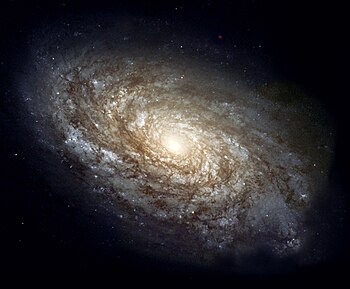| Galaxies are so large that stars can be considered particles next to them (Photo credit: Wikipedia) |
In the first meeting, I introduced myself, saying: "I'm Mike Wolf, from planet Earth."
I don't usually introduce myself that way. Oddly, I learned that one of the other people in the group regularly introduces himself that way (the "from planet Earth" part, not the "I'm Mike Wolf" part.)
Later, I explained: "I'm not a native. I'm visiting." But that's not quite right, so I thought I'd start by correcting the record.
I'm a science guy. I majored in math and minored in physics at MIT and according to the best science we know, I am, right here and right now, at the exact center of the universe. I find it helpful to remind myself of that, every once in a while. So I'm from here, the exact center of the universe.
Here's why the available evidence points to that.
According to modern science, the origin story of the universe--and thus of each of us--is some variation of what's called the "Big Bang Theory." According to the theory, the universe has not been around forever. We believe that started about 13.798 ± 0.037 billion years ago from a single point, and it's been expanding ever since. There's quite a bit of speculation about what happened during the first trillionth of a second, but after about 10−11 seconds, things are fairly well understood.
Two things we know with high certainty and have known for a long time: the speed of light in a vacuum is constant, and the universe is expanding. We also know that the further away an object it, the faster it's travelling away from us.
So we know that when we look further and further out in space we are actually looking further and further back in time. At cosmological scales the standard unit of distance measurement is a light-year, which is the distance that light travels in one year. What that means is that any light we see from an object a light-year away was really produced a year ago.
Two things we know with high certainty and have known for a long time: the speed of light in a vacuum is constant, and the universe is expanding. We also know that the further away an object it, the faster it's travelling away from us.
So we know that when we look further and further out in space we are actually looking further and further back in time. At cosmological scales the standard unit of distance measurement is a light-year, which is the distance that light travels in one year. What that means is that any light we see from an object a light-year away was really produced a year ago.
The oldest and most distant galaxy we've seen so far is 13.1 billion light-years away, which means that the light from that galaxy was emanated 13.1 billion years ago, or a mere 700 million years after the universe started. But that's not the most ancient electromagnetic emanation that we've detected. It turns out that there's something called the Cosmic Microwave Background, only detectable with radio telescopes, which is believed to be the afterglow of the Big Bang itself.
Now think about where that Big Bang happened. Let's suppose it happened a billion miles in that direction. If it did then when we aimed our radio telescopes in that direction we'd see a stronger glow than if we aimed our radio telescopes in some other direction. But that's not what we see. What we see is that the glow is uniform in every direction which means, that no matter where you are, you are at the place where the big bang happened.
So this spot, right here, if you went back in time, would be the center of the universe. I am at the center of the universe. But the really cool thing is that each of you are at the center, too. We are all, each at the place where, long, long ago, the universe began.

No comments:
Post a Comment